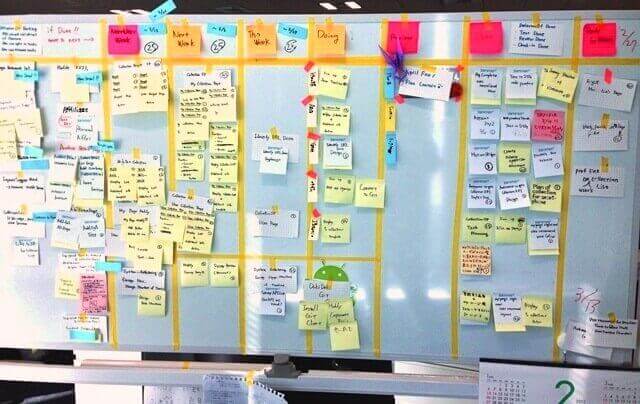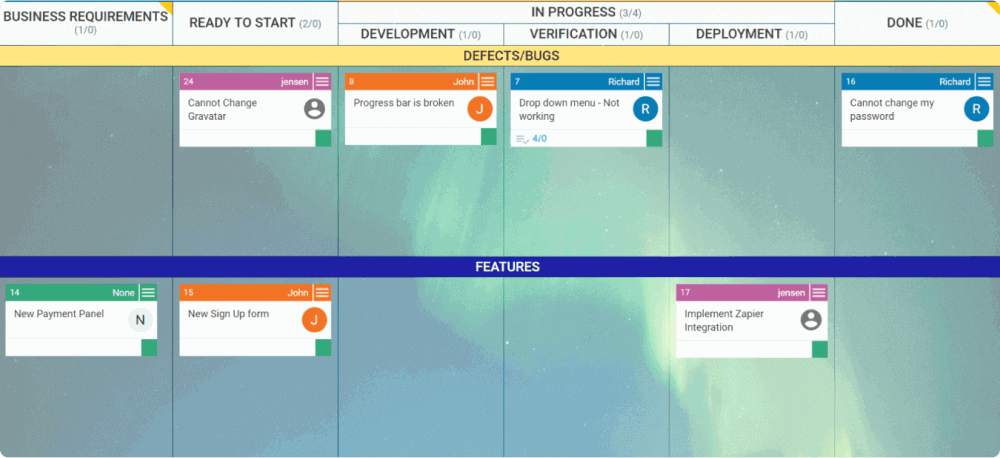“When you visualize, then you materialize.” This quote from the American psychologist Denis Waitley perfectly summarizes one of the most effective tools modern leaders use for managing their time, team process, or even entire companies.
Although there are different means to use for visualizing work, there’s hardly any tool capable of outperforming task boards. That is, of course, if you know how to make the most of it.
If you are not confident that you’ve mastered the art of workflow visualization, I suggest you stick to the end. What awaits you in the next paragraphs will help you gain a better understanding of:
- what a task board is
- who can use a task board
- why you need it
- what types of task boards are available
- how you can make the most of them.
What Is a Task Board?
Simply put, a task board is a “board where you visualize all your tasks”. Task boards are used by individuals, teams, and entire organizations to help them efficiently complete work. Such boards are usually divided into a few columns representing the work process, and tasks come in the form of cards.
Task boards can be as basic as a plain whiteboard with a list of items you want to complete or a complex digital kanban board integrated with multiple other platforms.
Why do I say kanban board? The majority of task boards available are very similar in structure to the ones used in Kanban, consisting of multiple columns that represent different steps that an assignment must pass to be completed. However, remember that there's still a significant difference between kanban and task board.
Who Can Use a Task Board?
The short answer here is anyone who wants or has the need for it (or simply everyone).
The long answer is that visual management boards are no longer solely designed to cater to the needs of software engineering teams. Thanks to technological progress and their adaptable nature, task boards are now versatile tools that can be utilized across various workflows in any business setting.
Some of the key users of task boards include:
- Software Development Teams: Task boards help developers track user stories, tasks, bugs, and other work items throughout the development lifecycle.
- Project Management Teams: Task boards provide a visual representation of project progress, allowing teams to identify bottlenecks, prioritize work, and ensure that deadlines are met.
- Marketing and Creative Teams: Task boards help marketers, graphic designers, content creators and other professionals to collaborate, track project status, and ensure that marketing initiatives are executed effectively.
- Operations and Support Teams: Task boards help IT support, customer service and other operations teams to manage tickets, incidents and requests. These teams use task boards to prioritize and address issues efficiently, ensuring that service levels are met, and customer satisfaction is maintained.
- Personal Productivity: Individuals, freelancers, entrepreneurs, and professionals in various fields use task boards as personal productivity tools.
Why Do You Need a Task Board?
Task boards can take your personal “To-Do” list to the next level by giving you the opportunity to gain a far more comprehensive perspective on all your affairs.
Unlike your personal “To-Do” list, a task board may show you how far along toward completing an assignment you are. You just need the discipline to update the progress on your board promptly.
To explore the full range of benefits of task boards, we need to examine their typical use cases.
What Are the 2 Main Types of Task Boards?
Visual management boards can be categorized into 2 main types:
- Physical task boards
- Digital task boards
Physical Task Boards
In general, physical or manual task boards are made on a wall or whiteboard using sticky notes. Boards are located where all team members have access to them and serve to organize everything a team needs to accomplish.

Example of a physical task board
Manual task boards usually have simple designs, including just a few columns for the different stages of progress. The main benefit of implementing a physical task board is that you can easily manage your tasks and rearrange their order of execution in case of unforeseen circumstances.
Remote teams that decide to use manual task boards may have difficulty with team collaboration and real-time updates of task progress.
Digital Task Boards
Digital task boards are great for transparently displaying who is doing what at all times. With real-time updates, they facilitate collaboration, offer data insights, and provide much more work flexibility to the team.
To be effective, these boards need to mirror the process steps that your team follows when working on their assignments. Modern kanban software solutions, for instance, offer a rapidly growing number of custom features, integrations, and customizations that easily cover task management and allow you to focus on improving your process flow, delivery speed, etc.
With the help of team electronic task boards, you can monitor how work items are progressing and how much work is on the table for your team. This will allow you to manage the capacity of your team based on the current workload.
How to Make the Most of Your Task Board?
Putting up a visual task board is quite easy, but making the most of it - is not so much. What you’ve read so far is scratching the surface of all the value it can deliver to you and your team.
Over the years, I’ve learned from experience that visualizing your workflow is barely enough to manage your personal, team, or company assignments effectively. This is why I’ll share 3 tips for making the most of task boards' possibilities.
Tip 1. Make Your Boards Globally Available
Physical task boards are fantastic for building the habit of visualizing your work and updating its status based on progress. However, as you become more adept, you’ll start noticing some limitations. Even with contemporary communication tools, updating a physical board when all team members are dispersed will require additional effort and come with some lag, as real-time updates will be quite challenging.
On the other hand, online task boards allow you to manage your work from anywhere with an internet connection.
Most contemporary software solutions include various other added functionalities, such as workflow analytics, card dependencies, and the ability to integrate with other platforms. With their help, you’ll be able to turn your board into a globally available base of operations for your organization.
Tip 2. Match Your Task Board Layout to Your Process
To make the most of your team board, consider the specific steps of your team’s process. Afterward, map them on the board in a way that tells you more about their status than their progress.

Visualizing a work process using a team work management board
For example, a typical software development board would have the following columns:
- Tech Design
- Coding
- Testing
You can even draw horizontal lines across your board to build swimlanes to distinguish between different priorities, types of work, etc.

Online work management board with mapped process steps and types of work
Tip 3. Turn Your Task Board into a Tool for Improvement with Kanban
As I mentioned earlier in this article, most task board layout templates that you’ll find available were inspired by the visual boards used in the Kanban method. This is not a coincidence, as the method relies heavily on visualization to achieve continuous process improvement leading to evolutionary organizational change.
Putting up a task board will help you see what you’ve got going on and what awaits in your backlog. Implementing it in combination with the rest of the kanban practices will help you manage your workflow in an increasingly efficient way and achieve continuous improvement.
Following this logic, I encourage you to start slowly if you have no experience using Kanban boards. It is wise to begin with a simple board that mirrors exactly your work process. This way, you and your team can see the benefits of using Kanban boards and avoid internal resistance.
Task Boards: A Good Starting Point
Task boards are fantastic tools for visualizing your work. They are by far superior to any “To-Do” list, as boards provide a more comprehensive perspective on managing your tasks.
Starting with a physical whiteboard is a good way to build a habit of keeping your task board up to date, but in time you may need some of the added functionalities of online task board solutions.
Last but not least, don’t rush to complicate your task board until you understand the dynamics of managing a complex process and have given your team enough time to get comfortable visualizing their work. Kanban can be a great ally on that mission!

Alex Novkov
Content Lead
Energetic and practical, passionate about social media, creative writing, heavy weights, and outdoor activities.



